10.1. Trade, Colonialism, and the Origins of Global Society
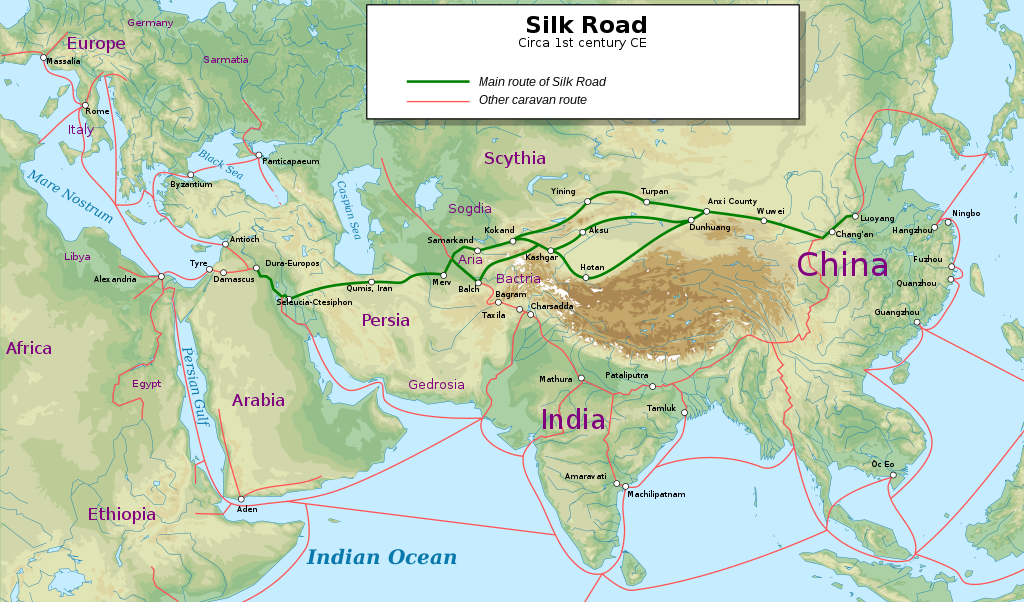
Robertson (1990) has argued that an understanding of global society has to begin with the long historical processes by which “the global system has been and continues to be made.” Although he cites the 2nd Century Roman historian Polybius, who noted that “[f]ormerly the things which happened in the world had no connection among themselves…. [b]ut since then all events are united in a common bundle,” it was not until the “germinal phase” of globalization in early modernity (15th – 18th century) that it became realistic to talk about humanity becoming organized as a single global society. Interestingly, Robertson argues that the process of dividing the world into separate national societies was itself an aspect of globalization, rather than an existing or ‘natural’ state of affairs replaced or undermined by globalization.
Robertson (1990) defines several stages on the path to the creation of global society:
Phase I: the germinal phase (15th – mid-18th century)
Phase II: the incipient phase (mid-18th century – 1870s)
Phase III: the take-off phase (1870s – mid-1920s)
Phase IV: the struggle-for-hegemony phase (mid 1920s – mid-1960s)
Phase V: the uncertainty phase, (1960s – present)
These stages can be mapped onto the development of colonialism and contemporary globalization, as described in the sections below.
Silk Roads (1st Century BCE–5th Century CE, and 13th–14th Centuries CE)
People have been trading goods and connecting over distances for almost as long as people have been around. In North America, for example, before the arrival of Europeans, Mississippian culture (ca. 500–1400 BCE) extended from the lower Great Lakes to the southeastern-most points of North America. Mississippians traded goods as far afield as the Bow Valley in Alberta, the Tiger Hills in southern Manitoba, along the Wəlastəkw — a.k.a. St. John River — in what is now New Brunswick, and in the farming villages of the Eastern Woodlands of the southern Maritimes, Quebec and Ontario (Belshaw, Nichel, & Horton, 2020).
In terms of the creation of global society, it was not until the 1st century BCE that a key step towards globalization occurred (Vanham, 2019). The development of the 6500 kilometre long Silk Road marked the shift from trade as a local or regional practice to becoming a global phenomenon. Luxury items originating from China began to appear in Rome, marking the first time in history that such products had traveled such a great distance. Regular trading between distant societies began to become routinized.
Although the intercontinental trade of luxury goods such as silk and spices between Asia and Europe had begun, it was not yet a full-fledged globalization. Silk was mostly a luxury good, and so were the spices that were added to the intercontinental trade between Asia and Europe. As a percentage of the total economy, the value of these exports was tiny, and many middlemen were involved to get the goods to their destination. Nonetheless, global trade links were established, and those involved in the trade reaped significant profits, with prices often multiplying by dozens from purchase to final sale.
The success of the Silk Road was largely due to the dominance of two great empires that controlled much of the trade route. Interruptions in trade were typically caused by blockades from local enemies of Rome or China. The eventual closure of the Silk Road after several centuries was due to the fall of these empires. When the road was reopened during Marco Polo’s travels in the late medieval period (1271–1295), it was due to the rise of a new dominant empire — the Mongols. Throughout history, the pattern of trade’s success has been linked to the protection provided by dominant empires, and its decline has been associated with the weakening or fall of these empires.
Spice Routes (7th–15th Centuries)
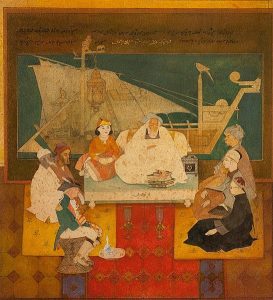
Islamic merchants were responsible for the next phase of global trade (Vanham, 2019). With the widespread dissemination of Islam from its Arabian origins in the 7th century, trade also began to expand in all directions. The prophet Mohammed, who founded Islam, was a renowned merchant, as was his wife Khadija, thus making trade a pivotal component of the religion and its adherents. By the early 9th century, Muslim traders had already established dominance over trade in the Mediterranean and Indian Ocean regions, and eventually expanded their reach as far east as Indonesia, which later became a Muslim-majority country, and as far west as Moorish Spain.
During the Middle Ages, the primary focus of Islamic trade was on spices, which had been traded mainly by sea since ancient times. By the medieval era, spices had become the central focus of international trade. Among these spices were cloves, nutmeg, and mace from the renowned Spice Islands located in the Maluku islands of Indonesia. These spices were in high demand in Europe and incredibly expensive. Therefore, they were still considered luxury items, and the trade remained relatively low-volume. Although globalization had not yet taken off, the original Belt (sea route) and Road (Silk Road) of trade between East and West was established.
Age of Colonization (15th–18th Centuries)
The Age of Colonization marked the beginning of truly global trade (Vanham, 2019). This era, starting from the late 15th century, connected the East and the West through the efforts of European explorers who also accidentally discovered the Americas. The scientific revolution in fields like astronomy, mechanics, physics, and shipping aided these explorations by Portuguese, Spanish, Dutch, and English explorers. They first discovered lands unknown to Europe, then subjugated them, and ultimately integrated them into their economies, a process referred to as colonialism.
The Age of Colonization had a significant impact on the world. The discovery of the Americas by Columbus, which almost destroyed pre-Columbian civilizations, is the most infamous example. However, the circumnavigation of the globe by Magellan was perhaps more consequential for the process of globalization. It opened the door to the Spice Islands, eliminating Arab and Italian middlemen. Although trade remained small compared to total GDP (Gross Domestic Product), expanded global integration considerably transformed people’s lives on a global scale.
For example, the European colonization of the Americas initiated the Columbian Exchange (Crosby, 2003), the enormous widespread exchange of plants, animals, foods, human populations (including slaves), communicable diseases (like smallpox), and culture between the Eastern and Western hemispheres. It was one of the most significant global events concerning ecology, agriculture, and culture in history. New crops like corn, potatoes, tomatoes, tobacco and chocolate that had come from the Americas via the European seafarers in the 16th century significantly contributed to the world’s population growth and to the formation of new habits of life around global products.
Colonialism
Two key developments contributed to the form and nature of global integration during this period. The first was the development of colonialism. Colonialism is a form of domination in which a state or state sponsored group exercises direct control over the territory and inhabitants of another society (Horvath, 1972; Mahoney, 2010). Colonization implies the power to settle, govern and extract resources from a foreign territory even in the face of resistance by its inhabitants. Marx (1977) described this process as primitive accumulation: wealth generated by separating people from a territory and its resources, and subjecting them to unfree labour (e.g., slavery, peonage), expropriation of land, and destruction of previously self-determining communities.
From the point of view of those inhabitants, local political structures and Indigenous self-government, including the Indigenous capacity to exercise control over their own territory, are forcibly eliminated, neutralized or rendered subordinate to the colonizing power. From the point of view of global integration, colonialism coercively subsumed a huge proportion of the planet to European control and supplanted local, isolated economies; first with mercantilism and then with global capitalism.
For the European colonizers of the early modern period, colonial dispossession of Indigenous inhabitants was legitimated through the doctrine of Terra Nullius or “nobody’s land” — the idea that territory and economic resources that are not being effectively utilized by an Indigenous population “could legitimately be expropriated and developed by a superior invading nation” (Lieven, 2000). Ideologies that characterized Indigenous People as inferior, savage, childlike or uncivilized, and therefore in need of colonial government further supported this notion. In this way colonization could be presented as a type of “civilizing mission.”
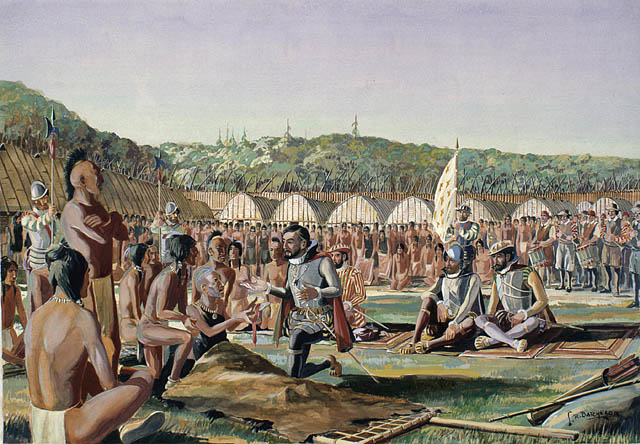
In the development of the European colonial empires, two major forms of colonialism were utilized, which had significant impact on the formation of contemporary global inequality (discussed later in the chapter): colonies of exploitation and colonies of settlement (Pares, 1937; Shipley, 2020). As Shipley (2020) sums it up: “Though no two cases are identical, it is possible to distinguish between these two categories of colonialism: those designed primarily for economic exploitation (Spanish America, British India and the Dutch East Indies) and a more settler-oriented colonialism (British North America, French Algeria and Portuguese Brazil).”
The formation of the 16th-century Spanish Empire for example was based largely on exploitative colonialism in which its colonies in the Americas and elsewhere were treated as sources of natural resources to exploit, especially precious metals. Efforts to conquer and enslave the inhabitants were focused on the extraction of wealth. The violent exploitation of the “mountain of silver” in Potosí, Bolivia, in the 16th and 17th century, described by Eduardo Galeano in Open Veins of Latin America (1973), is a grim example. The Spanish colonists imposed a forced labour system known as the mita, in which Indigenous Incans from hundreds of miles away were forced to labour in the mines and then carry a daily quota of 25 45kg bags of silver ore to the surface. This lead to a demographic collapse of Incan society in the area. Thousands of Incans and African slaves died before the resource was exhausted at the end of the 17th century, but the silver funded the Spanish colonial empire and provided the key ingredient of capitalism — fluid money — that enabled the global exchange of slaves, fabrics, spices, silk, porcelain, tea and other goods on a permanent basis.
On the other hand, the British colonization of the Americas took the form of settler colonialism, involving permanent European settlement and displacement of Indigenous Peoples. The colonies that became Canada, the United States, New Zealand, Australia and South Africa were settler colonies. While the colonization of Western Canada in the 19th century might appear less directly violent than in Potosí, the Canadian government used the collapse of population due to epidemic disease, the decimation of the buffalo and an active policy of starvation to force Indigenous Peoples off their land and onto relatively unproductive reserve lands to make way for railway development and advancing European settlement (Daschuk, 2013).
The Sovereign State System
The second development of global integration in this period is related to the first: the formation of the sovereign state system. As discussed in Chapter 17. Government and Politics, the sovereign state system is the structure by which the world is divided up into separate and indivisible sovereign territories. Prior to the early modern age, feudal Europe and most of the world was divided into a complex patchwork of small overlapping jurisdictions with uncertain borders, sometimes held in allegiance to empires like the Mongol Empire or the Holy Roman Empire. Secular or political authority was often at odds with religious authority or entwined with it in complex ways. It was not until the Peace of Westphalia (1648) at the end of the Thirty Years War that the modern nation-state system can be said to have come into existence based on the principle of sovereignty: the political form in which a single, central “sovereign” or supreme lawmaking authority governs within a clearly demarcated territory.
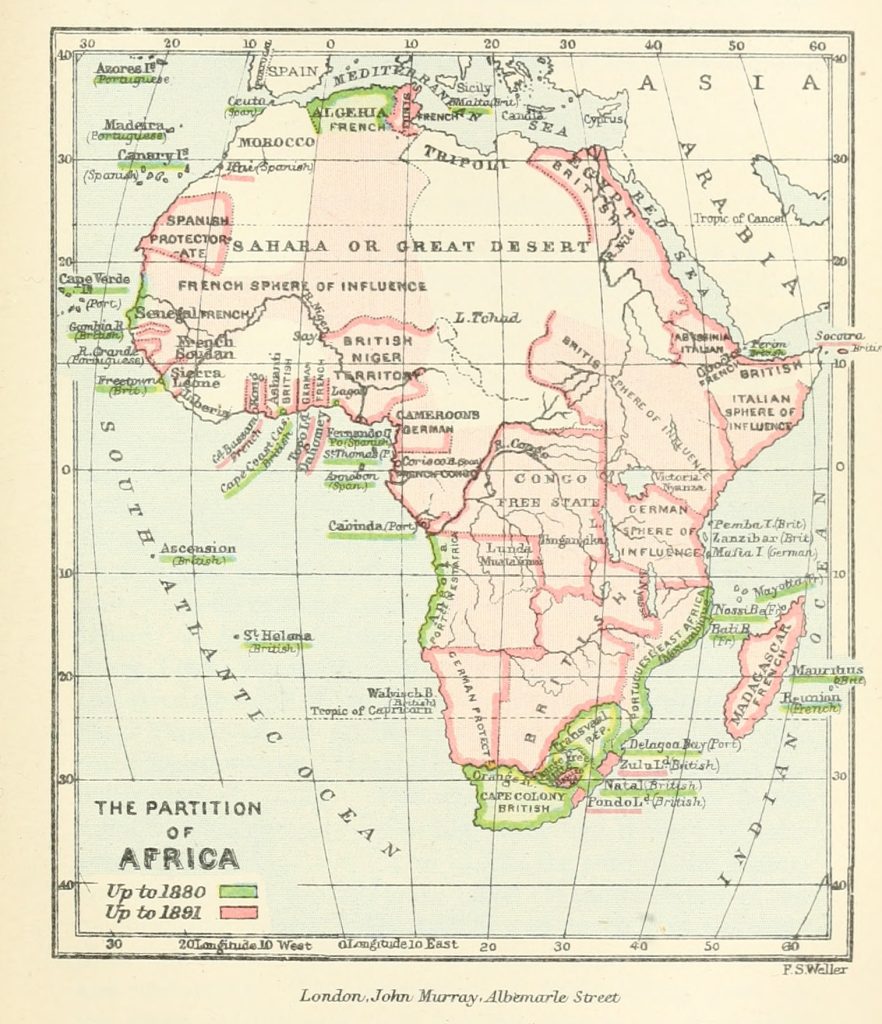
It might seem ironic today that the development of the sovereign state system was a key component of early globalization. The separation of societies into discrete sovereign territories and nations is often presented as a source of resistance to processes of globalization, which tend to bypass or break borders down. However, the division of the entire globe into territorially separate states (except for the oceans and Antarctica) was a mechanism that imposed a single model of political community onto every corner of the Earth. Combined with colonialism, eight different European nation-states controlled and defined the territories of what eventually became 125 different nation-states (Abernethy, 2000). The arbitrariness of where the colonial borders were drawn remains a significant source of conflict today, particularly in the Middle East and Africa where artificial borders often cut through existing ethnic communities or combined rival communities into a single sovereign territory.
Moreover, the modern state system imposed a structure onto global politics that remains in effect to this day (Walker, 1993). Whereas states claim the power to regulate and control processes within their borders, the international relations between states are unregulated except through diplomatic agreements and voluntary international norms, which are generally not backed by force. While order is maintained by “the sovereign” within each sovereign state, outside the state or between states there is no sovereign to enforce law. The international sovereign state system is inherently unstable in this sense, and war is always a possibility as individual states pursue their interests.
In addition, as noted earlier with the container ship example, the modern state system means that while individual states have jurisdiction or authority over processes occurring within their borders, their capacity to act is restricted to the many issues affecting their populations that are global in scale. Regulating maritime traffic is one example, but finding adequate, global-level responses to issues ranging from climate change to global poverty, to the spread of misinformation in social media is inherently tenuous.
According to some sociologists, the early Age of Colonization may not be considered as true globalization as the resulting global economy was still segmented and unbalanced (Vanham, 2019). Although trade became global and was the main reason for colonization, the European Empires primarily established global supply chains with their own colonies. Additionally, their colonial model was centred on exploitation and primitive accumulation, which included the disgraceful legacy of the slave trade. Therefore, the empires developed a mercantilist and a colonial economy, but not a genuinely globalized one. Nevertheless, it was during this period that the entire world was reconfigured around a new centre of power in Europe, which for the first time in human history had the power to shape historical events all over the planet (Shipley, 2020).
Three Waves of Globalization (19th Century–1914, 1945–1989, 1989–Present)
First Wave
The period from the 19th century up to 1914 saw the emergence of the true first wave of globalization (Vanham, 2019). During this time, Great Britain rose to global dominance both in terms of its global empire of colonies, and in terms of its early industrialization, thanks to new technologies like the steam engine and spinning jenny. This was the era of the industrial revolution.
 |
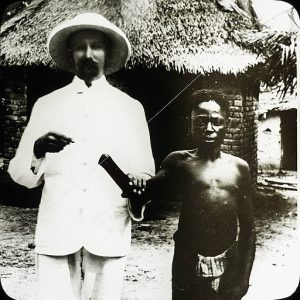 |
The industrial revolution in Britain provided a powerful driving force for global trade through two main factors (Vanham, 2019). Firstly, the development of steamships and trains facilitated the efficient transportation of goods over long distances, both domestically and internationally. Secondly, the industrialization of Britain allowed the production of inexpensive goods, such as iron, textiles, and manufactured items, which were in high demand globally. As the economist John Maynard Keynes observed: “The inhabitant of London could order by telephone, sipping his morning tea in bed, the various products of the whole Earth, in such quantity as he might see fit, and reasonably expect their early delivery upon his doorstep” (cited in Globalist, 2001).
Although Britain was the primary beneficiary of the first wave of globalization due to its significant capital and technological advancements, other countries also benefited from it. With the invention of the refrigerated cargo ship in the 1870s, countries like Argentina and Uruguay were able to export meat on a large scale, which led to their golden age. Other countries also began to specialize and trade in goods in which they were most competitive.
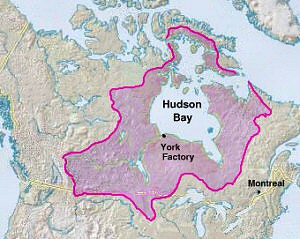
John Maynard Keynes noted that a similar situation was also true in the world of investing. International banking structures, the invention of the joint stock corporation and then the modern private corporation facilitated the global circulation of capital investment, as well as the physical infrastructure of globalization. Individuals with financial resources in major cities like New York, Paris, London, or Berlin had the ability to invest in joint stock companies that were engaged in international activities.
The Hudson’s Bay Company, for example, was an early joint stock company that was granted control and exclusive trading rights over the huge territory of “Rupert’s Land” traversed by rivers flowing into Hudson Bay as early as 1670 (Ray, 2009). This effectively drew most of what became Western Canada and the Northern United States into the global economy. Another joint stock corporation was the French Compagnie de Suez. It constructed the Suez Canal between 1859 and 1869, connecting the Mediterranean with the Indian Ocean and opening yet another artery of world trade. Others built railways in Canada, the United States and India, or managed mines in African colonies.
The 19th century also entrenched the processes of colonization (Vanham, 2019). By the end of the 19th century, “most [globalizing and industrialized] European nations grabbed for a piece of Africa, and by 1900 the only independent country left on the continent was Ethiopia” (Stokes Brown, 2022). Similarly, major countries such as India, China, Mexico, or Japan, once powerful, were subdued either militarily or economically by Europe and the United States. They were either unable or not permitted to adjust to the industrial and global trends. Western powers placed restrictions on their development, or they could not compete due to their limited access to capital or industrial technology. Finally, globalization did not benefit many workers in industrialized nations, either — their work became subservient to industrial machinery, or their employment was undercut by competition from imports.
Second Wave
Between the First and Second World Wars, global integration regressed as world powers entered the “struggle for hegemony” phase of globalization (Robertson, 1990). But the end of World War II marked a second wave of globalization. Formal decolonization dismantled the European Empires as many former colonies fought for and attained independence. This did not mean economic independence however as many were quickly subsumed into forms of neo-colonialism in a restructured global order.
At first, this happened in two separate tracks that continued the struggle for hegemony phase described by Robertson (1990). The Cold War divided the world into two spheres of influence: the communist Warsaw Pact lead by the Soviet Union and the capitalist order lead by the United States. In the capitalist sphere of influence, under the hegemony (i.e., leadership) of the United States, and aided by new technologies like the car and the plane, global trade and foreign investment started to rise again.
Key to developing global integration in this phase was the formation of several new global level institutions at the end of the Second World War. These were based on international negotiations and agreements to enable political, economic, and non-governmental affairs to be globally coordinated. The United Nations was formed in 1945, focusing on collective security following the failure of the former League of Nations to prevent World War II. The UN also created measures for protecting global health and human rights, including the 1948 Universal Declaration of Human Rights and the World Health Organization. In terms of economic coordination, the International Monetary Fund (IMF) and the World Bank (WB) were created as global institutions to help control the destructive ups and downs of global markets, which had been acute problems during the interwar period, and to ensure stable currencies. Similarly, Non-Governmental Organizations (NGOs) like Amnesty International, Oxfam, Greenpeace, etc. emerged to play an increasingly important role outside of government to address global scale problems and foster a sense of global citizenship and responsibility.
Third Wave
When the “Iron Curtain” dividing East and West fell in 1989, the Soviet Union collapsed, and globalization entered its third wave. The newly created World Trade Organization (WTO) encouraged nations all over the world to adopt a neo-liberal model of globalization (discussed later in the chapter), including free trade agreements that reduced political barriers to the circulation of capital, investment, and commodities. Increased circulation of people and their labour through migration diversified populations worldwide. In 2001, even China, which was a secluded, agrarian economy for most of the 20th century, became a member of the WTO, and started to manufacture for the world. Since then, the world has been increasingly dominated by two global powers, the U.S. and China.
At the same time, new technologies from the Third Industrial Revolution — computerization, the internet and digital technology — connected people all over the world in an even more direct way. The orders Keynes could place by phone in 1914 could now be placed over the internet. Instead of having them delivered in a few weeks, they could arrive at one’s doorstep the next day. Digital technology, communication and banking allowed for a further global integration of supply and production chains, as noted earlier in the chapter. These digital technologies continue to eliminate distance around the globe through instantaneous e-commerce, digital services, 3D printing, artificial intelligence and, of course, social media.
The changing configuration of global capitalism and international relations in the 3rd wave of globalization has been described by some as the reemergence of empire (Hardt & Negri, 2000). Instead of the historical empires organized from a single centre like the Roman Empire, British Empire, or Post WWII American hegemony, contemporary empire is arguably organized around a fluid, ad hoc network of international agreements, supra-national agencies and transnational corporations (Negri, 2004). Alongside the numerous trade agreements, which have harmonized economies and removed tariff borders that restrict the flow of capital and goods, in recent decades frequent global “police actions” and trade embargoes have been enacted by various “coalitions of the willing” to enforce global peace or intervene in domestic policy (in, for example, Yugoslavia, Somalia, Afghanistan, Iraq, Libya, Syria, Ukraine, etc.). Similarly, the Paris Agreement on climate change or the Ottawa Treaty on landmines are examples of global initiatives that blur the sovereign jurisdictions and boundaries of the sovereign state system.
Effects of Globalization
The effects of this globalization have been uneven. Later in the chapter, the formation of a fluid, global, late modern culture which disembeds people from locality, organizes them through global scale expert systems and exposes them to planetary risks, will be discussed.
In terms of the economic aspects of globalization, some have argued that a majority of the global population has benefited from this: more people than ever before belong to the global middle class, having achieved this status by participating in the global economy. But many workers, especially in the West, have become skeptical about a political and economic system that has resulted in increased economic inequality, job insecurity, social instability, outsourcing, capital disinvestment, and immigration. Outsourcing shifts production to low-wage enclaves, displacement leads to sectors of precarious employment in the traditionally wealthy global north, global markets compel people to migrate from rural to urban areas and “slum cities,” legal and illegal immigration from poor countries to rich countries fuels xenophobia, while large numbers of workers simply become redundant to global production and turn to informal, casual labour. This has lead to both anti-globalization movements that challenge the corporate focus of neo-liberal globalization and neo-populist, anti-immigrant movements that seek to arrest globalization altogether.

More significantly, for much of the world patterns of systematic underdevelopment persist. Sub-Saharan Africa for example is poorer in the 2020s than it was during the period of decolonization (Broadberry and Gardner, 2022). The debt it owes the developed world, including increasingly to China, has quadrupled since the 1970s, largely under the auspices of loans and structural adjustment programs (SAPs) provided by the International Monetary Fund (IMF) and the World Bank (WB). These programs come with the requirement to adopt free market policies including liberalization of trade, privatization, and reduction of barriers to foreign capital. But the interest alone that African states pay to service the debts is half of their annual revenue, meaning that this phase of globalization has taken the form of perpetual debt bondage. Global Justice Now (2017) report that the continent loses more money each year through multinationals repatriating profits and illegally moving money into tax havens than it receives in aid, investment, and remittances. Walter Rodney’s (1972) analysis remains salient: “When the terms of trade are set by one country in a manner entirely advantageous to itself, then trade is usually detrimental to the trading partner.”
In Rodney’s view, rather than seeing contemporary globalization as the end of the period of colonialism, it would be more accurate to describe the expansion of global inequality and the economic underdevelopment of many former colonies as forms of neo-colonialism. Where decolonization refers to the process whereby former colonies attained formal political self-determination and independence from colonial powers, neo-colonialism describes the way in which decolonization often masks the continued socio-economic and political dominance of external powers in matters of domestic policy, resource extraction and labour exploitation. While the decolonized state appears to be independent and has total control over its dealings, the society remains structured and organized around neo-colonial relationships and interests (Nkrumah,1965). As Walter Rodney (1972) argued in How Europe Underdeveloped Africa, after the period of formal decolonization Western Europe and Africa continued to have a relationship “which insured the transfer of wealth from Africa to Europe.”
Media Attributions
- Figure 10.5 Silk Road in the I century AD by Kaidor is used under a CC BY-SA 4.0 licence.
- Figure 10.6 Sindbad the Sailor by Abanindranath Tagore, 1930, is in the public domain.
- Figure 10.7 Jacques Cartier at Hochelaga by Lawrence Batchelor (1933) is in the public domain.
- Figure 10.8 The partition of Africa by unknown illustrator (1901) is in the public domain.
- Figure 10.9 Workmen Leaving Platt’s Works, Oldham 20th August 1900 by unknown photographer is in the public domain.
- Figure 10.10 Victim of Congo atrocities, Congo, ca. 1890-1910 by unknown photographer is in the public domain.
- Figure 10.11 Map of Rupert’s Land by Matthew Trump, 2004 is used under a GNU Free Documentation Licence.
- Figure 10.12 Walter Rodney by unknown photographer, via Wikipedia, is used under fair dealings provisions in the Canadian Copyright Act, or with a Non-free use. Wikipedia Free Use licence rationale.

